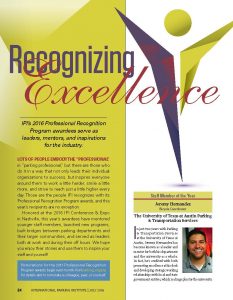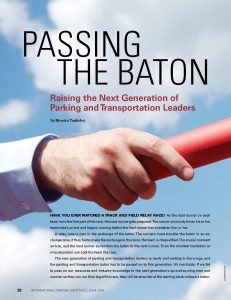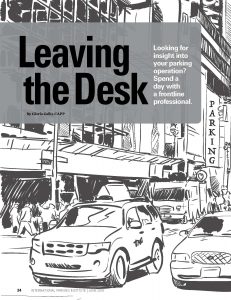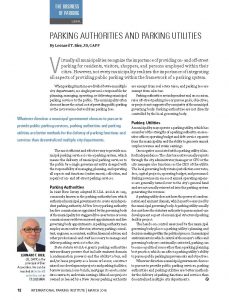Recognizing Excellence
IPI’s 2016 Professional Recognition Program a wardees serve as leaders, mentors, and inspirations for the industry.
wardees serve as leaders, mentors, and inspirations for the industry.
LOTS OF PEOPLE EMBODY THE “PROFESSIONAL” in “parking professional,” but there are those who do it in a way that not only leads their individual organizations to success, but inspires everyone around them to work a little harder, smile a little more, and strive to reach just a little higher every day. Those are the people IPI recognizes with its Professional Recognition Program awards, and this year’s recipients are no exception.
Honored at the 2016 IPI Conference & Expo in Nashville, this year’s awardees have mentored younger staff members, launched new programs, built bridges between parking departments and their larger communities, and served as leaders both at work and during their off hours. We hope you enjoy their stories and use them to inspire your staff and yourself!
Staff Member of the Year
Jeremy Hernandez | Bicycle Coordinator
The University of Texas at Austin Parking & Transportation Services
In just two years with Parking & Transportation Services at the University of Texas at
Austin, Jeremy Hernandez has become known as a leader and mentor for both his department and the university as a whole. In fact, he’s credited with both promoting excellence at his desk and developing strategic working relationships with local and state government entities, which is a huge plus for the university.
Hernandez oversees the daily operation of the bicycle program, which includes education, maintenance, enforcement, project coordination, wayfinding and communication, community events, auctions, and the daily operations of the campus bicycle shop. He also oversees the Orange Bike Project (a student-led initiative) and the BikeUT Twitter account, where he’s generated more than 600 messages about the university bike program and biking in general. This outreach has spilled over to Bike Texas, where he cultivates an active working relationship to spread the word about safe cycling throughout Austin and the state. Additionally, he works with the City of Austin to coordinate the city’s and university’s bike programs.
Hernandez was instrumental in procuring 100 new bike racks and 1,000 new bicycle parking spaces on campus, some in locations previously inaccessible. He suggested permeable surfaces to create bike parking in areas that weren’t suitable for it before, which combined a new parking addition with a sustainability element.
The UT-Austin Bike Auction, which attracted more than 500 people this year, also owes much of its success to Hernandez; it raised more than $20,000 to support campus bike infrastructure. And he’s done all of this with a great, positive attitude, terrific work ethic, and willingness to both get his hands dirty and lead by example.
Supervisor of the Year
Cathy Harrison | Office Supervisor
Arizona State University Parking & Transit Services, Tempe Campus
Cathy Harrison is one of those people everyone wants to work with. Kind, compassionate, helpful, and motivated, she’s worked with Arizona State University Parking & Transportation Services for more than 20 years.
A supervisor for the past 10 years, Harrison and her staff of seven serve more than 100,000 students and employees. She greets every co-worker and customer every day and helps boost morale, leading by example to encourage her employees to make smart decisions and taking a sincere interest in her crew and customers.
Harrison started her career with Arizona State University as a part-time employee and worked her way up to supervisor, giving her keen insight into each employee’s duties and challenges. Customers know they can rely on her to find the best possible accommodation for each unique situation, and she’s the recipient of several Sun Awards, which are given by university staff to their peers for individual excellence.
She was the first female president of a local chapter of the Tempe and Arizona Jaycees and guided her chapter to a “Chapter of the Year” designation. She is a Life Member of the Tempe Jaycees and received an Arizona Jaycee Senatorship in 1991; she was also named Outstanding Program Manager by the U.S. Jaycees for her work with St. Jude Children’s Research Hospital.
Lifetime Achievement Award
H. Carl Walker, PE | Chief Executive Officer
Carl Walker, Inc.
H. Carl Walker is wellknown throughout the parking industry as a pioneer in the design of new parking structures and has contributed much to the industry throughout his career. It all started at Precast Industries, Kalamazoo, Mich.; he eventually went to work with T.Y. Lin, an engineering consultant and professor at Cal Berkeley, and designed his first garage: a 600-space structure for General Motors in Detroit, Mich.
Walker founded the company that became Walker Parking Consultants in 1965 and launched what is now Carl Walker, Inc., in 1982. Walker has been personally involved in more than 2,500 parking projects during his career, including parking studies, structural engineering for parking structures, functional design of parking structures, prime design of more than 500 completed structures, restoration projects, and serving as expert witness on many projects.
Early in the 1970s, he led the development of standards for criteria to design parking decks; the manual included vertical loads and other information vital to long-lasting structures. Walker says memories of good projects are usually based on respecting the people who ran them and the good relationships formed during the process. But he’s also known for more technical successes, including:
- Introducing design concepts that include the use of mercury vapor, sodium vapor, and metal-halide high-intensity lighting; glass-backed elevators; PVC drainage systems; the archistructure concept of structural concrete design; and durability design of extended service life.
- Developing the first standards for criteria to design parking decks.
- Speaking around the world.
- Writing articles about parking structure design and restoration.
- Being named an adjunct professor at the University of Michigan.
- Receiving multiple awards from IPI, the University of Michigan, and other organizations.
- Founding four companies specializing in parking consulting, design, and restoration.
Emerging Leader of the Year
Blanca Gamez | Assistant Director, Parking & Transportation Services
The University of Texas at Austin
Blanca Gamez was hired as a student assistant for special events for the University of Texas at Austin’s Parking & Transportation Services department back in 2000. She worked there until her graduation in 2004, returned to the department as an administrative associate in 2006, earned her master’s degree in public administration and urban and environmental planning, and along the way established herself as a transportation expert and leader both with the university and in the parking industry.
Gamez has held positions on multiple transportation organization boards and worked through numerous organizations to mentor young women preparing for careers in science, technology, engineering, math, and transportation. She’s also an academic coach for the College of Natural Sciences Texas Interdisciplinary Program and a senior advisor with the Con Mi Madre program, where she works with Latina women preparing to go to college.
Gamez is known for working with many groups to build support for car sharing, including establishing an innovative partnership with Zipcar; after seeing the success of the program at the university level, the City of Austin expanded its share program in a similar way. She made changes to the university carpool program that grew it from 50 users to nearly 1,500. And among her greatest successes is the BikeUT program, where she’s developed mixed-use pathways, increased the number of bike lockers and racks, established a bicycle hub and fix-it stations, led bicycle appreciation events, and mentored the student-led Orange Bike Project, which provides short-term rentals for students.
In 2014, Gamez began working on her PhD in adult, professional, and community education and expects to graduate in a few semesters.
Parking Organization of the Year
Texas Tech University Transportation & Parking Services
During one weekend in November 2015, the Texas Tech University campus hosted the first men’s basketball game of the season; a conference volleyball game; the first round of the NCAA soccer tournament; a Lady Raiders Basketball Education Day game with 105 buses carrying 6,000 children; the final home football game with more than 55,000 fans; a press conference with more than 200 attendees; and 15 additional special events, along with the normal departmental operations on a campus with 35,000 students and 6,000 employees. Five years ago, this feat would have been next to impossible. Today, Texas Tech University Transportation and Parking Services (TPS) handles days like these with relative ease.
After years of complaints, heckling, parking shortages, insults unsuitable to print, and weekly editorial cartoons in the student newspaper blasting the department, TPS placed an intense focus on customer service and technology improvements.
First to come online was a license-plate-recognition (LPR) system coded for university parking use in August 2010. The switch went over extremely well with customers. The department continued its forward progress in fall 2013 with eCitations (the first paperless parking ticket program), becoming the first university parking system to commercialize its software.
Texas Tech also saw a large increase in students using alternative transportation. By fall 2015, 54 percent of students biked, walked, bused, or carpooled to campus. To handle the growth, TPS built bike parking areas, began reselling abandoned bicycles, and assisted the student government association with the management of bus routes and apartment route contract payments. The department changed its name from University Parking Services to Transportation and Parking Services to reflect the wider focus.
Customer service programs expanded:
- Communications increased permit-holder notifications by email and text.
- Marketing created the Bike Clinic, a free event for campus cyclists, winning an inaugural IPI Parking Matters® Marketing & Communications Award and earning plenty of campus news coverage.
- Toys for Tickets encourages customers to exchange a new, unwrapped toy for dismissal of a parking citation.
- Expectant Mother Parking (EMP) and Temporary Assistance Parking (TAP) programs provide closer parking to permit holders at no charge.
- The free Motorist Assistance Program (MAP) saved 944 stranded motorists on campus in fiscal year 2015.
- TPS developed a first-citation dismissal program to give students one citation at no charge to chalk it up to a learning experience.
- The new abandoned bike sales program returned 130 bicycles to students and employees in 2014—its pilot year—and 342 in 2015.
- Increased staffing and training helps create a great first impression with families at Raider Welcome move-in events and an increased presence at dozens of campus resource fairs.
- Proactive Twitter and Facebook accounts provide additional customer service and communications outlets.
Increased efficiency led to increased sales, greater lot utilization, less abuse, and higher and multiple revenue streams. The customer-service focus stopped the editorial cartoons and instead led to informative pieces about parking updates and programs. TPS is now known for its flexibility, openness, service, and efficiency.
Parking Organization of the Year
The University of Texas at Austin, Parking & Transportation Services
As the fastest-growing large city in the U.S., Austin, Texas, is in a race for space, and on the University of Texas at Austin campus, the landscape is no different. New buildings are being erected each year where once there were surface parking lots. As these lots make way for academic progress, the university’s Parking and Transportation Services (PTS) department has adapted by moving parking to the periphery of campus and establishing a robust transportation system. With a campus of more than 75,000 people; events bringing in 100,000+ on a given day; a new medical school on the way; and only 90 full-time PTS employees, PTS runs efficient, innovative, and dedicated operations to provide access and mobility.
PTS added two garages in the past five years, and another three are currently underway. Along with adding electric vehicle (EV) charging stations in an older garage, the newest garage is LEED certified, and PTS is seeking Green Garage Certification (now Parksmart) for those under construction. Once complete, PTS will manage 12 garages and 50 surface lots, totaling nearly 17,000 spaces. Along with lot- and garage-specific permits, low-cost general surface permits are available to access periphery surface lots, and frequent buses transport parkers to and from central campus. PTS also offers a low-cost permit that provides access to periphery surface lots during the day and all-garage access at night and on weekends.
Event and departmental guest parking options include custom event garage access cards, single-use access cards, scratch-off permits, and online event parking through Click and Park, which has collected $350,000 in online event sales since 2012; 12 percent of event parking permits were purchased online last semester.
Within the past two years, PTS has focused on expansion of online services, adding the ability to recharge garage debit cards, as well as manage permit waitlist selections. The university shuttle system has 10 dedicated routes to shuttle individuals around campus, as well as to student housing areas in Austin. PTS partners with the local public transportation provider to offer university affiliates fare-free rides on both the shuttle system and 70 mainline system routes. PTS also collaborated with the university athletics department to provide the Longhorns Express bus service between remote lots and the stadium on football game days.
The uRide 24-5 program operates five days per week providing fare-free car service home from the library after midnight, while uRide Safe Ride was designed to give students safe, no-charge car rides home from the downtown entertainment district. It joins PTS’s other collaboration, the E-Bus, which provides fare-free bus service to and from downtown.
One of PTS’s biggest pushes in recent years has been to improve cycling on campus. PTS’s BikeUT program has semester auctions and runs The Kickstand, a bike hub selling supplies and loaning tools and offering registration. Recently, PTS also began managing a shop where cyclists can rent bikes or use tools.
James M. Hunnicutt, CAPP, Parking Professional of the Year
Anne Guest | (Retired) Director
Missoula Parking Commission
During Anne Guest’s 20-year tenure, the Missoula Parking Commission (MPC) evolved into a full-service agency that builds and manages parking in the Missoula, Mont., community and serves as a major player in local economic development initiatives.
One of the characteristics that sets the MPC apart from most parking programs in the country is its level of community engagement. The MPC and Guest were involved in a wide range of community initiatives, including active involvement with almost every community development agency and significant institutional organization in Missoula. The positive and intimate relationship of the MPC to the Missoula Downtown Association, the Missoula Redevelopment Agency, and the Downtown Business Improvement District formed the basis of a cohesive and well-integrated downtown partnership.
Guest and the MPC worked closely with several other organizations to create a comprehensive and integrated access management network in downtown Missoula. The MPC became an effective contributor in the community and economic development arenas along with parking and transportation.
Under Guest’s leadership, the MPC became a major funding partner and active participant in the Greater Missoula Downtown Master Plan. Perhaps the most significant parking program action item to emerge from this was the decision to build a significant new parking garage to support a focus on retail growth. The Park Place garage was an important catalyst project for the community and won an IPI Award of Excellence.
Guest also oversaw the development of a parking strategic plan, which was an integrated element of the Greater Missoula Downtown Master Plan. The MPC adopted a strategic framework of 10 guiding principles that aligned parking philosophies and programs with the larger downtown strategic goals and objectives. To keep the community informed of the parking program’s progress, the MPC created an annual report that further explained the importance and contributions of the MPC. The report included a section titled “Why Parking Matters.”
Finally, Guest oversaw an upgrade to the latest modern multi-space meter technology that added a wide range of positive downtown customer service enhancements.
James M. Hunnicutt, CAPP, Parking Professional of the Year
Melinda Alonzo, CAPP | Director, Parking & Transit
Arizona State University Parking & Transit Services
To many, parking is thought of as merely two stall lines, nine feet apart, that designate where a car can be left unattended. To Melinda Alonzo, it’s about leading-edge technology, abundant alternate transportation options, and innovative programs with an unwavering focus on customer service.
In 2011, Alonzo introduced Service Blueprinting to Arizona State University Parking & Transit Services (ASU PTS). More than 60 PTS employees have participated in Service Blueprinting training, mastering a versatile and practical technique that visualizes service processes and delivery from a customer’s point of view.
Under Alonzo’s stewardship, bicycling at ASU has blossomed into a program that boasts three card-access bicycle parking facilities; four bike valet stations; nearly 4,000 registered bicyclists; and 25 percent more bike racks on campus than there were just three years ago.
In 2006, she created an in-house communications team to facilitate more effective and timely information to PTS customers. This venture proved so successful that the associate vice president for university business services employed the team to assist other departments with their communications efforts. Alonzo developed the Gimme-A-Break program in 2007—vehicles not in the parking database system receive a $0 citation upon their first parking citation on campus. She also established the Eco-Pass, which allows for 30 all-day in/out parking privileges at a designated parking structure or lot. This program makes taking alternate forms of transportation more attractive because it provides commuters with a safety net during rainy-day situations.
In what is perhaps the most tangible proof of giving back to the campus community, Alonzo created the Benefactor Program to donate parking revenue to a university program or student-run organization. More than $18,000 has been donated to Arizona State University’s American Dream Academy, Student Health Outreach for Wellness, and the ASU School of Art combined.
TPP-2016-07-Recognizing Excellence
 Parking payment technology has advanced from the spare change in your wallet to an app on your phone hosted in the cloud. Digital parking apps and services provide ease and convenience to both parties to a digital parking transaction. However, while feeding quarters in a parking meter is a rather anonymous transaction, the use of a digital platform for a parking transaction requires a user to provide, and a company to store, personal and financial information of its users. This creates a duty for parking technology providers to properly secure and safeguard highly-valuable, protected personally identifiable information.
Parking payment technology has advanced from the spare change in your wallet to an app on your phone hosted in the cloud. Digital parking apps and services provide ease and convenience to both parties to a digital parking transaction. However, while feeding quarters in a parking meter is a rather anonymous transaction, the use of a digital platform for a parking transaction requires a user to provide, and a company to store, personal and financial information of its users. This creates a duty for parking technology providers to properly secure and safeguard highly-valuable, protected personally identifiable information.






